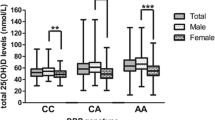Abstract
The genetic influence on bone mineral density (BMD) is thought to be mediated in part by alleles at the vitamin D receptor (VDR) locus. In order to assess the effect of VDR on BMD in premenopausal women, we studied 470 healthy white subjects, aged 44–50 years, participating in the Women's Healthy Lifestyle Project. Each participant was genotyped for theBsmI polymorphism at the VDR gene locus. BMD at the lumbar spine, hip and whole-body, and the whole-body soft tissue composition, were measured cross-sectionally using a Hologic QDR 2000 densitometer. The presence of a polymorphic restriction site at the VDR gene locus was specified asb, whereas absence of this site wasB. The frequency distribution of the VDR genotype was:bb, 20.6%;Bb, 39.1%; andBB, 40.2%. Spinal BMD (mean±SD) was significantly lower in women with VDR genotypeBB (1.038±0.11 g/cm2) as compared with those with genotypebb (1.069±0.12 g/cm2,p<0.05). Trochanter BMD was 2.7% lower in those with genotypeBB versusbb (0.685±0.10 g/cm2 vs 0.708±0.09 g/cm2). A similar trend was shown at each subregion of the hip, but not at the whole-body. In premenopausal women, allelic status at the VDR locus contributed to variations in spinal and trochanteric BMDs, but the absolute difference in BMDs was small, amounting to 0.26 and 0.23 standard deviations, respectively. It is concluded that in this population of healthy premenopausal women there was a significant association between polymorphisms at the VDR gene locus and both spinal and trochanteric BMDs, yet no association was demonstrated for the whole-body BMD.
Similar content being viewed by others
References
National Institute of Health. Osteoporosis: Cause, treatment, prevention. Publication no. 86-2226. NIH, 1986.
Pocock NA, Eisman JA, Hopper J, Yeates M, Sambrook PN, Eberl S. Generic determinants of bone mass in adults. J Clin Invest 1987;80:706–10.
Krall EA, Dawson-Hughes B. Heritable and life-style determinants of bone mineral density. Bone Miner Res 1993;8:1–8.
Morrison NA, Cheng J, Tokita A, et al. Prediction of bone density from vitamin D receptor alleles. Nature 1994;367;284–7.
Spector TD, Keen RW, Arden NK, et al. Influence of the vitamin D receptor genotype on bone mineral density in postmenopausal women. a twin study in Britain. BMJ 1995;310:1357–60.
Gallagher JC, Goldgar D, Kinyamu H, Fannon P. Vitamin D receptor genotypes in type I osteoporosis [abstract.] J Bone Miner Res 1994; 9(Suppl 1): S143.
Hustmyer FG, Peacock M, Hui S, Johnston CJ, Christian J. Bone mineral density in relation to polymorphism at the vitamin D receptor gene locus. J Clin Invest 1994;94:2130–4.
Looney J, Fischer M, Yoon H, et al. Lack of evidence for an increased prevalence of the BB vitamin D receptor genotype in severe osteoporosis [abstract]. J Bone Miner Res 9(Suppl 1):S148.
Nguyen TV, White C, Jones G. et al. The effects of vitamin D receptor alleles on bone density in the elderly [abstract]. J Bone Miner 1994;9(Suppl l):S110.
Riggs BL, Nguyen TV, Melton LJ, et al. The contribution of vitamin D receptor gene alleles to the determination of bone mineral density in normal and osteoporotic women. J Bone Miner Res 1995;10:991–6.
Block G, Dresser CM, Hartman AM, Carroll MD. Nutrient sources in the American diet: quantitative data from NHANES 2 Survey. Vitamins and minerals. Am J Epidemiol 1985;122:13–26.
Miller SA. Dybes DD, Polesky HF. A simple salting out procedure for extracting DNA from human nucleated cells. Nucleic Acids Res 1988:16:1215–8.
Hustmyer FG, DeLuca HF, Peacock M. ApaI, BsmI, EcoRV and TaqI polymorphisms at the human vitamin D receptor gene locus in Caucasian, blacks and asians. Human Mol Genet 1993;2:487.
Fleet JC, Harris SS, Wood RJ, Dawson-Hughes B. The BsmI vitamin D receptor restriction fragment length polymorphism (BB) predicts low bone density in premenopausal black and white women. J Bone Miner Res 1995;10:985–90.
Ferrari S, Rizzoli R, Chevalley T, Slosman D, Eisman JA, Bonjour JP. Vitamin D-receptor-gene polymorphisms and change in lumbar spine bone mineral density. Lancet 1995;345:423–4.
Keen RW, Major PJ, Lanchburgh JS, Spector TD. Vitamin D receptor polymorphism and bone loss. Lancet 1995;345:990.
Kroger H, Mahonen A, Ryhanen S, Turumen AM, Alhava E, Maenpaa P. Vitamin D receptor genotypes and bone mineral density. Lancet 1995;345:1238
Matsuyama T, Ishii S, Tokita A, et al. Vitamin D receptors and bone mineral density. Lancet 1995;345:1239.
Krall EA, Parry P, Lichter JB, Dawson-Hughes B. Vitamin D receptor alleles and rates of bone loss: influences of years since menopause and calcium intake. J Bone Miner Res 1995;19:978–84.
Author information
Authors and Affiliations
Rights and permissions
About this article
Cite this article
Salamone, L.M., Ferrell, R., Black, D.M. et al. The association between vitamin D receptor gene polymorphisms and bone mineral density at the spine, hip and whole-body in premenopausal women. Osteoporosis Int 6, 63–68 (1996). https://doi.org/10.1007/BF01626540
Received:
Accepted:
Issue Date:
DOI: https://doi.org/10.1007/BF01626540



